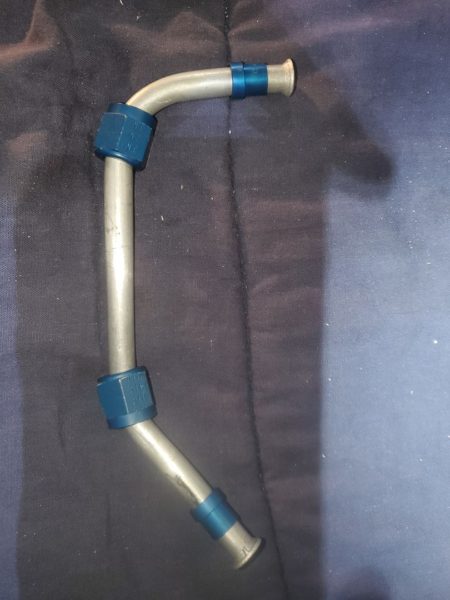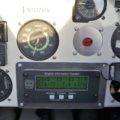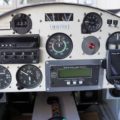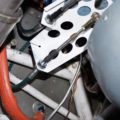One of several areas that I wanted to clean up while down for the new engine was the fuel system inside the cockpit.
Fuel flows from one of the wing tanks thru the fuselage and to the engine. To get there, it flows thru the fuel selector valve, thru an auxilary fuel pump, thru a fuel filter and then to the firewall. From firewall it flows to the engine driven fuel pump, to a fuel flow transducer, and then to the carbureator where it makes the propellor spin. 😉
Nothing wrong with any of that except for the location of some of the bits. Specifically, the fuel filter and fuel flow transducer locations. The former was previously in a spot that was difficult to access and that means that it probably wasn’t checked/cleaned as often as it should be. The latter was is a little gizmo that tells the instrumentation how much fuel is flowing to the engine – which is very handy information! I decided to move it into the fuselage to reduce the number of connections on the engine side of the firewall and put those sensative electronics in a ‘better’ environment (less heat and vibration).
So, the fuel filter & aux fuel pump needed moved from the forward end of the ‘tunnel’ (a long, fore-aft compartment between the pilots legs in the belly of the aircraft fuselage) to the same compartment in the belly that contains the fuel valve and control stick. This is much easier to access for routine maintenance. To make things a bit easier, the fuel flow transducer was mounted in the tunnel since it rarely needs to be accessed.
With everything relocated, it had to be connected. In the RV-4, these fuel lines are fabricated from 3/8″ hard aluminum tubing and AN fittings. The way that is done is a bunch of measuring, fitting, trimming, measuring, bending, trimming, fitting, repeat… until you get the line just right! Then you slip on the AN fittings and flare the end. It is actually a very enjoyable task – but it does waste some tubing – or at least I wasted some tubing.
Tubing is wasted when you make an incorrect bend – wrong direction, too much, too little, mess up the flare, etc… Some tubing is wasted when the goofball putting the AN fittings on does it incorrectly. Like backwards or missing. I know… who would do that?!?! The photo above shows a completely wasted effort. The tubing is good but the little blue sleeves near the ends are on backwards. There is no way to fix this. Trash it and start over again! A great way for a hard headed person to learn!! 🙄
The bender that I’m using is a fairly basic one – similar to this one on Amazon.
The following photo shows the finished product. The black part with the chrome tubing sticking out is the control stick so you are looking down into the belly of the aircraft. The fuel valve is the round brass colored item at the top-left (without the handle attached), fuel filter is the black cylinder, and aux fuel pump is the square thing. The shiny aluminum lines are the new ones recently fabricated for these changes.
This is looking forward into the ‘tunnel’ (also the ‘belly’ of the aircraft). The red square cube is the fuel flow transducer. The fuel is measured as it flows thru that ‘cube’ and the instrumentation on the panel displays the flow (gallons per hour) and keeps track of the total fuel used.
The entire system was flow tested and pressure tested for leaks and we are good to go!
Obviously, much work is in progress so cleaning and tidy-up work remains but there is forward progress on this big project!!








Your posts about the airplane engine are way beyond me! At least someone in the family is a genius! 😉
Text me sometime when you have a minute to chat.
Not a genius, just a pilot and mechanic.